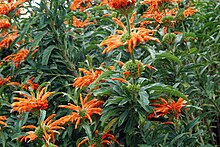Leonotis leonurus
| Leonotis leonurus | |
|---|---|

| |
| Scientific classification | |
| Kingdom: | Plantae |
| Clade: | Tracheophytes |
| Clade: | Angiosperms |
| Clade: | Eudicots |
| Clade: | Asterids |
| Order: | Lamiales |
| Family: | Lamiaceae |
| Genus: | Leonotis |
| Species: | L. leonurus
|
| Binomial name | |
| Leonotis leonurus (L.) R.Br.[1]
| |
Leonotis leonurus, also known as lion's tail and wild dagga, is a plant species in the

Description
The shrub grows 3 to 6 ft (1 to 2 m) tall by 1.5 to 3.5 feet (0.46 to 1.07 m) wide.[2] The medium-dark green 2–4 inches (5.1–10.2 cm) long leaves are aromatic when crushed. The plant has 1.75 inch (4.5 cm) tubular orange flowers in tiered whorls (verticillasters) typical to the mint family,[6] that encircle the square stems. They rise up to three feet (0.9 meters) above the foliage mass during the summer season, with flowering continuing into winter in warmer climates.[2][7]
Variation in flower color
A white variety (known colloquially as 'Alba') and a yellow variety also exist.
Ecology
The native habitat of Leonotis leonurus is damp grasslands of southern Africa.[8] It attracts nectivorous birds (mainly sunbirds), as well as various insects such as butterflies. The flowers' mainly orange to orange-red colour and tubular shape are indicative of its co-evolution with African sunbirds, which have curved bills suited to feeding from tubular flowers.
Cultivation
Leonotis leonurus is cultivated as an
Lion's tail can be found in other subtropical and Mediterranean climate regions beyond South Africa, such as California, Hawaii,[7] and Australia where it has naturalized in some areas. In cooler climates it is used as an annual and winter conservatory plant.[2]
Pharmacology and toxicology
Marrubiin has both antioxidant and cardioprotective properties and has shown to significantly improve myocardial function.[10][11]
Leonotis leonurus contains several labdane diterpene–based compounds such as Hispanolone, Leonurun, and Leoleorins. C-N[4]
One experimental animal study suggests that the aqueous leaf extract of Leonotis leonurus possesses
An animal study in rats indicated that in high doses, lion's tail has significant toxicological adverse effects on organs, red blood cells, white blood cells, and other important bodily functions. Acute toxicity tests in animals caused death for those receiving a 3200 mg/kg dose. A 1600 mg/kg extract led to changes in red blood cells, hemoglobin concentration, mean corpuscular volume, platelets, and white blood cells.[14]
Traditional uses
Infusions made from flowers, seeds, leaves, or stems are widely used to treat
Legal status
Latvia
Leonotis leonurus has been illegal in Latvia since November 2009, and is classified as a Schedule 1 drug. Possession of quantities up to 1 gram are fined up to 280 euros. Possession and distribution of larger quantities can be punished with up to 15 years in prison.[19]
Poland
Leonotis leonurus was banned in Poland in March 2009. Possession and distribution lead to criminal charges.[20]
See also
References
- ^ "Leonotis leonurus". Germplasm Resources Information Network. Agricultural Research Service, United States Department of Agriculture. Retrieved 2008-12-04.
- ^ a b c d e f MBC-Kemper Center - Leonotis leonurus . accessed 7.7.2011
- ISBN 978-1-4822-1987-6.
- ^ a b Ofentse Mazimba (2015). "Leonotis leonurus: A herbal medicine review" (PDF). Journal of Pharmacognosy and Phytochemistry. 3 (6): 74–82. Retrieved 17 May 2022.
- ^ "Online Etymology Dictionary". Etymonline.com. Retrieved 8 February 2016.
- ^ Bailey, Liberty Hyde (1935). The Standard Cyclopedia of Horticulture - Volume II. New York: The MacMillan Co. p. 1839.
- ^ a b c "PLANTS Profile for Leonotis leonurus (lion's ear)". United States Department of Agriculture Natural Resources Conservation Service. Retrieved 28 March 2010.
- ISBN 978-1-4822-5064-0.
- ISBN 978-1-919777-30-6.
- ^ Popoola KO Elbagory AM, Ameer F, Hussein AA. Marrubiin. Molecules 2013; 18(18):9049-9060.
- ^ XinHua, 2010
- PMID 33172494. Retrieved 17 May 2022.
- PMID 16082426.
- S2CID 27776434.
- ^ Van WJB, van OB, Gericke N. Medicinal plants of South Africa. Briza Publications. Cape Town, 2000.
- ^ Noumi E, Houngue F, Lontsi D. Traditional medicines in primary health care: plants used for the treatment of hypertension in Bafia, Cameroon. Fitoterapia 1999; 70(2):134-139.
- ^ Hutchings AH, Scott G, Lewis AB. Cunningham, Zulu medicinal plants, an Inventory. Natal University Press, Pietermaritzburg, 1996, 266-267.
- ^ Watt JM, Breyer BMG. Medicinal and poisonous plants of Southern Africa. E & S Livingstone. Edinburg, 1962.
- likumi.lv. Retrieved 2013-06-23.
- ^ (in Polish) Dz.U. 2009 nr 63 poz. 520, Internetowy System Aktów Prawnych.
